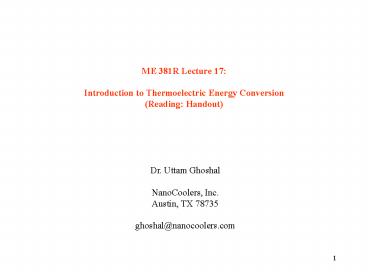ME 381R Lecture 17: - PowerPoint PPT Presentation
1 / 18
Title:
ME 381R Lecture 17:
Description:
Sections 17-1 to 17-5 ... Energy recovery from automobile engines ... Automobile refrigeration. TE combined with fluidics for better heat exchangers ... – PowerPoint PPT presentation
Number of Views:37
Avg rating:3.0/5.0
Title: ME 381R Lecture 17:
1
ME 381R Lecture 17 Introduction to
Thermoelectric Energy Conversion (Reading
Handout)
Dr. Uttam Ghoshal NanoCoolers, Inc. Austin, TX
78735 ghoshal_at_nanocoolers.com
2
References
Thermo-electrics Basic principles and New
Materials Development by Nolas, Sharp and
Goldsmid Thermoelectric Refrigeration by
Goldsmid Thermodynamics by Callen. Sections 17-1
to 17-5 Abram Joffe, The Revival of
Thermoelectricity, Scientific American, vol.
199, pp. 31-37, November 1958.
3
Outline
- Thermoelectric Effects
- Thermoelectric Refrigeration
- Figure of Merit (Z)
- Direct Thermal to Electric Power Generation
4
Applications
Cryogenic IR Night Vision
Water/Beer Cooler
Si bench
TE
Electronic Cooling
Cooled Car Seat
Laser/OE Cooling
5
Seebeck Effect
- In 1821, Thomas Seebeck found that an electric
current would flow continuously in a closed
circuit made up of two dissimilar metals, if the
junctions of the metals were maintained at two
different temperatures.
S dV / dT S is the Seebeck Coefficient with
units of Volts per Kelvin S is positive when the
direction of electric current is same as the
direction of thermal current
6
Peltier Effect
- In 1834, a French watchmaker and part time
physicist, Jean Peltier found that an electrical
current would produce a temperature gradient at
the junction of two dissimilar metals.
? lt0 Negative Peltier coefficient High energy
electrons move from right to left. Thermal
current and electric current flow in opposite
directions.
(electronic)
7
Peltier Cooling
? gt0 Positive Peltier coefficient High energy
holes move from left to right. Thermal current
and electric current flow in same direction.
q?j, where q is thermal current density and j
is electrical current density. ? ST (Volts)
S 2.5 kB/e for typical TE materials
T is the Absolute
Temperature
8
Thomson Effect
- Discovered by William Thomson (Lord Kelvin)
- When an electric current flows through a
conductor, the ends of which are maintained at
different temperatures, heat is evolved at a rate
approximately proportional to the product of the
current and the temperature gradient.
is the Thomson coefficient in Volts/Kelvin
Seebeck coeff. S is temperature dependent
Relation given by Kelvin
9
Kelvin Relations
TE Heat Conduction
for Bi chalcogenides
10
Thermoelectric Refrigeration
The rate of heat flow from one of the legs (i1
or 2)
(1)
11
The rate of heat generation per unit length due
to Joule heating is given by
(2)
Eqn 2 is solved using the boundary conditions T
Tc at x0 and T Th at x l. Thus it is found
that
(3)
The total heat removed from source will be sum of
q1 and q2
qc (q1 q2 )x0
(4)
Eqs. 1, 3, 4?
K Thermal conductance of the two legs R
Electrical Resistance of the two legs
12
The electrical power is given by
COP is given by heat removed per unit power
consumed
Differentiating w.r. to I we get max. value of COP
can be reduced to unity by multistaging
where
A similar approach can be used to obtain the
maximum degree of cooling and maximum cooling
power.
13
It is obvious that z will be maximum when RK will
have minimum value. This occurs when
When this condition is satisfied z becomes
Further, if S2-S1 S, k1 k2 K, s1 s2 s
power factor
14
ZTm vs. COP
15
Thermoelectric Power Generation
- Used in Space shuttles and rockets for compact
source of power. - Energy recovery from automobile engines
- Diffusive heat flow and Peltier effect are
additive i.e. both reduce the temperature
gradient.
where w is the power delivered to the external
load and QH is the positive heat flow from source
to sink
16
Bismuth Chalcogenides
- Weak van der Waals bonds attenuate phonon
conduction - Sb substitutes Bi in Sb2Te3 and Se substitutes
Te in Bi2Se3 structures, and results in greater
mismatch in atomic masses - Alloys such as Bi0.5Sb1.5Te3 (p-type),
Bi2Te2.8Se0.2 (n-type) have ZTa 0.8 - Interface scattering in superlattices of Bi2Te3
and Sb2Te3 and ultra-thin films result in lower
phonon thermal conductivities - Phonon glass, electron crystal (PGEC)
17
Progress in ZT
Fundamental limitations k and s, S and s are
coupled.
18
Miscellaneous
- Bismuth telluride is the best bulk TE material
with ZT1 - Trends in TE devices
- Superlattices and nanowires Increase in S,
reduction in k - Nonequilibrium effects decoupling of electron
and phonon transport - Bulk nanomaterial synthesis
- Trends in TE systems
- Microrefrigeration based on thin film
technologies - Automobile refrigeration
- TE combined with fluidics for better heat
exchangers - To match a refrigerator, an effective ZT 4 is
needed - To efficiently recover waste heat from car, ZT
2 is needed































